Castor-oil plant
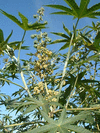
(Ricinus communis), large plant, of the spurge family (Euphorbiaceae), grown commercially for the pharmaceutical and industrial uses of its oil and for use in landscaping because of its handsome, giant, 12-lobed, palmate (fanlike) leaves. The bristly, spined, bronze-to-red clusters of fruits are attractive but often are removed before they mature because of the poison ricin concentrated in their mottled, beanlike seeds. Probably native to Africa, this species has become naturalized throughout the tropical world. The plants are chiefly cultivated in India and Brazil, largely for their oil. In the tropics the plants reach about 10 to 13 m (30 to 40 feet) in height. In temperate climates they are raised as annuals and grow 1.5 to 2.4 m in a single season. Although R. communis is the only species in its genus, there are hundreds of natural forms and many horticultural varieties.
Castor oil plant - evergreen shrub growing to
about 30 ft (10 m) in its natural state, but a much smaller annual when
cultivated. Castor oil plant has large, palm-shaped leaves, green female
flowers, and prickly red seed capsules.
When archeologists first went into 4,000-year-old Egyptian tombs, their
eyes were drawn to sparkling gems, precious metals, finely carved
statuary, and the stone sarcophagi in which ancient mummies rested. Only
later did they and other researchers pay much attention to the tiny oval
objects found in the tombs. Glossy and mottled, seldom more than 1/2
inch long, these objects looked like nothing more than polished bits of
marble. But further study showed the "stones" to be millennia-old castor
beans, the seeds of an African tree that now grows in warm areas
throughout the world and is cultivated by American and European
gardeners as a foliage plant.
In its native habitat, the castor oil plant is a tree 30 to 40 feet
high, bearing broad, deeply lobed leaves on long stalks. The leaves are
purple-bronze when young, gray-green or dark maroon when mature. The
petalless female flowers, borne in clusters above the male flowers,
develop into burlike capsules containing three seeds each. When the
capsules mature and dry out, they explode, scattering their beans.
Shrubby dwarf strains no more than 5 feet high have been developed in
cultivation, bearing nonexplosive capsules.
The Egyptians used castor oil, derived from the beans, as lamp oil and
as an unguent; they also purged their systems three times a month by
drinking the oil mixed with beer. The Greeks and Romans - taking note,
no doubt, that the beans are poisonous - used the oil only externally.
It was not until the late 18th century that the foul-tasting substance
regained its ancient role as a laxative.
The bean's poisonous substance, ricin, is one of the deadliest toxins
known; eating a single castor bean can kill a child. Fortunately,
extracting the oil without the ricin is a fairly simple process. The key
is temperature. Heat is used to extract oil from most seeds, but when
castor beans are heated, the ricin from the bean is distributed
throughout the oil. When the beans are hulled and crushed at
temperatures below 100°F, however, they yield a clear or yellowish
poison-free oil rich in another substance, ricinolein, which irritates
the intestines, causing them to expel their contents.
Castor oil has several commercial application as well. Because it is
insoluble in benzine and has a very low freezing point, it is well
suited for the lubrication of airplane engines. Castor oil is also used
in hydraulic brake fluids and in biodegradable laundry detergents, as
well as in paints and varnishes. Oil meant for these purposes is
extracted by heat and is poisonous.
Castor bean plant is probably native to eastern Africa. It is cultivated in hot climates around the world, especially in Africa and southern Asia. The seed capsules are gathered throughout the year when nearly ripe and are then put out in the sun to mature.
The seeds contain 45-55% fixed oil, which consists mainly of glycerides of ricinoleic acid, ricin (a highly toxic protein), ricinine (an alkaloid), and lectins. The seeds are highly poisonous -2 are sufficient to kill an adult -but the toxins do not pass into the expressed oil.
The castor oil plant - Ricinus communis is a very useful tropical foliage plant. It is grown from seed annually, easily reaching 10 foot plus (3m) in one season, (depending on the variety.)
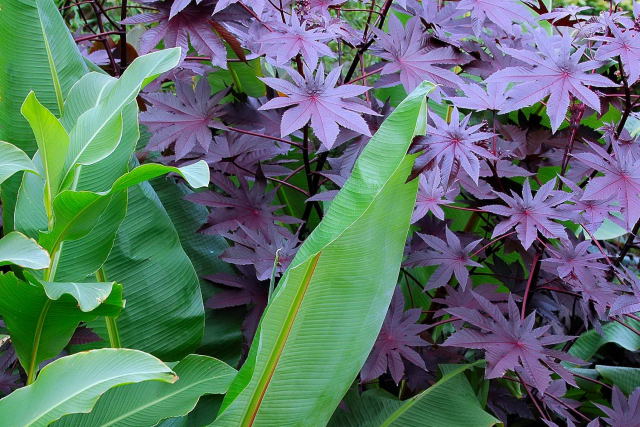
Castor oil plant- Ricinus Communis 'New Zealand Purple'
The one negative of the castor oil plant is the toxicity of the seeds. The seeds are said to be fatal if eaten and as such it is recommended that this plant is grown out of reach of children. If you are a nervous parent then perhaps this plant should be avoided altogether. However.... The seeds are generally held quite high on the plant, certainly out of reach of any very small children. The plants are also strong and unlikely to fall over in windy conditions were the seeds could be presented. Actually removing the seeds from their pods is also quite difficult. Once they are ripe though, the seeds pods explode sending the seeds every where. Again we have an 'however', the seeds do not reach this stage during the summer growing season (of a British summer).
When stored in the greenhouse over winter, the seed pods of the castor oil plant begin to explode early in the new year. At first you may be under the impression that those pesky boys from next door are throwing gravel over the garden wall, trying to annoy you. Then you remember there are no charming pranksters next door as a Ricinus communis seed lands squarely between the eyes. It is at this stage, when the greenhouse floor is awash with seeds, that they are there most dangerous to foraging children. Again if you have children that naturally put anything they come across into their mouths, you probably should avoid this plant. Educate your children about this plant. The decision whether or not to grow the castor oil plant is ultimately yours.
Propagation of Castor oil plants
Propagation of castor oil plants is by seed. These are widely available from seed catalogues. After one season you should be self sufficient in seeds as the seeds come true.
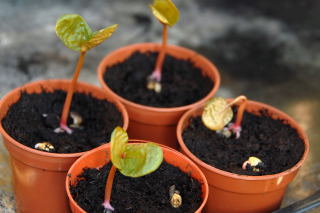
Newly emerging castor oil plant seedlings
Seeds should be planted in 3inch pots filled with multi-purpose compost. Push the seeds length wise into the compost. Do not plant them too deep as this seems to delay germination. Water the pots and allow them to drain. Generally the seeds of Ricinus communis germinate quite soon simply left in the greenhouse or indoors on a window sill. Placing the pots in a heated propagator is not necessary.
The young plants grow quite quickly. They need potting on as soon as
their roots start growing out of the bottom of the pots. If more than
one plant is growing per pot, divide them at this stage. Make sure the
compost is nice and wet and the plants will pull apart easily.
When planting castor oil plants in the garden they will need a rich soil and regular watering to establish them.
Ricinus communis 'Zanzi palm' is a big enough plant to be planted singularly. It will often branch as it gets taller.
Ricinus communis 'New Zealand purple' is less inclined to branch and benefits from being planted in groups of three. Planted on its own it can be a little spindlely.
Both plants are better suited to the back of the border due to their height and to prevent easy access by children. Make sure the young plants have plenty of access to light to ensure they can grow up at the rear of the border. Leave a gap of about a foot (20-30cms) between them and any other plant.
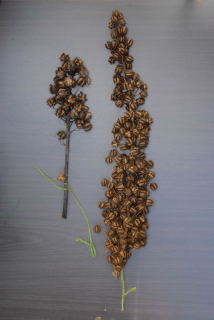
Castor oil plant dried seed spikes
By the end of the summer your castor oil plants should have produced a number of flower spikes. These should be covered in seed pods. One or two of these can be removed for next years plants. Hang them up by the stem to dry . Avoid laying the seed pods down as this can attract mould. These will then dry out over the winter as mentioned above.
The smaller spike pictured here is from Ricinus communis 'New Zealand purple', and the larger from Ricinus communis 'Zanzi palm'. The individual seed pods of the castor oil plant are shown in the picture below.
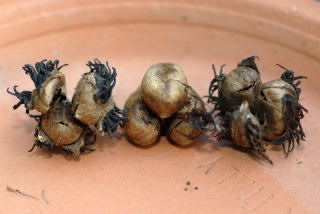
Castor oil plant seed pods
.
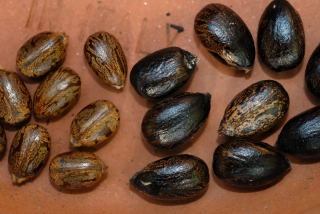
Castor oil plant seeds
Each one of these pods contains a seed. The pods need to be split apart to remove the seeds. Each flower spike from Ricinus communis 'Zanzi palm' contain hundreds of seeds, less on the Ricinus communis 'New Zealand purple' but still plenty. These are large plants that take up a lot of room so you do not need that many.
Because Ricinus communis produces so many seeds, you will only need harvest a small proportion. Leave the remainder of the seed spikes on the plant and add to the compost heap once the frost has destroyed the plant. When you then turn out that particular batch of compost on to the soil you will be presented with loads of self seeded castor oil plants. These can prove quite useful. Either you can transplant them to other parts of the garden or leave them where they are. Don't leave too many, the occasional one can come in handy for filling that awkward gap. If you find you have too many just pull them out. One thing you can do with self seeded castor oil plants is to remove the growing tips and create a lower growing bushy plant. This will need constant nipping to keep it the size you want. They are useful towards the end of the season when some other plants such as Dahlias have had enough. They push past and add a nice fresh bit of growth.
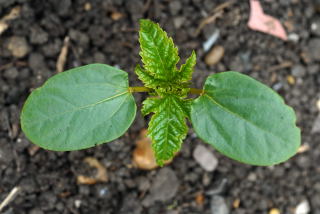
Castor oil plant self seeded seedling
This picture shows a self seeded castor oil plant. An advantage of growing any plant from seed is that it teaches you to recognise a desirable plant from one that isn't at the early stages. The compost heap, once emptied can be quite a treasure trove of seedlings, keep what you want hoe out the rest.
Text obtained from www.cooltropicalplants.com/Castor-oil-plant.html
This is a biennial plant that grows up to 10 m tall. In countries with temperate climates, it is cultivated as an annual plant. In its first year, it grows to 60-500 cm tall and perishes during autumn frosts. The root system consists of a well-developed taproot that reaches depth of 3-4 m. Stalk is hollow and branched. Leaves are large, 25-40 cm long, peltate, seven- or nine-bladed, glaberous, lustrous, on a long (25-60 cm) leaf stalk. Plant is green or red-violet, often with a thin, waxy coating. Inflorescences are racemes 60-80 cm long, located on the ends of branches. Male flowers occupy lower part of the raceme; female flowers occupy the upper part; all are apetalous. Fruits are spherical or oblong pods, 2-3 cm across, usually with prickles, three-celled, with 1 seed in each cell. Seeds are 8-20 mm across, oval, lustrous, with or without papilla-shaped excrescence (caruncle), gray to dark red with gray or other color mosaic. Plants are either cross- or self-pollinated; usually anemophilous. 2n=20Ecology.
Thermophilic plant, suffers from frosts. Shoots perish at temperatures below -1°C; adult plants die at temperatures below -3 to -4°C. Temperatures should not fall below 20-25°C to ensure normal plant development. It withstands some drought, although at least 300 mm of precipitation during the vegetative period is needed for growth. With moisture deficits, seed yield is sharply reduced. Requires fertile soil; produces high yield on fertile, well-aerated soils with a pH of 6-7.3. It is a short-day species, photophilous. Vegetative period (from shoot emergence to maturing of first raceme) lasts 100-150 days.Distribution.
This species originated in East Africa, where solid thickets of castor grow. Cultivation of castor in Russia was first recorded in 1840. In former Soviet times, crops occupied 132 thousand hectares. The crop is cultivated in the southern Ukraine (Zaporozhye, Kherson, and Dnepropetrovsk areas), in the Krasnodar and Stavropol territories, in the Rostov area, and in the Northern Caucasus. The crop is also grown on a smaller scale in the republics of Central Asia and in the Lower Volga region. Popular varieties include: VNIIMK 165, Hybrid ranny, Donskaja 39/44, Kruglik 5, Stepnaja 6, Krasnodarsky 3, Kubanskaja 15, and Chervonnaja.Utilization and economic value.
Seeds contain 40-58% non-drying oil, which has a special viscosity that does not harden at low temperatures. Oil is used to grease aviation motors, as well as in metallurgy, tanning, textiles, and soap-producing industries. It is also used to manufacture nylon fiber, linoleum, and various synthetic products. Oil is inedible and used as a laxative in medicine (castor oil). Oil cake is applied as a fertilizer. Fibers of stalks are used to make ropes and sacks. It is also raised as an ornamental plant. In crop rotation, it is usually placed after winter crops, such as sugar beet and corn. It is cultivated as a row crop. The crop is sown when soil temperatures are greater then 12-14?C. For wide-row crops, 25 to 30 kg seeds per hectare are sown; seeds are planted 8-10 cm deep. Ripens non-uniformly. Varieties with dehiscing fruits are gathered two to three times during the process of maturing; varieties with non-dehiscing fruits are processed with defoliants and harvested by combine. Productivity is 0.5-2 tons per hectare.Text from: http://www.agroatlas.spb.ru
Seeding and Propagation - caster beans
As long as the temperatures don't fall below 10 C and your plants are at least 6-8 inches tall, leave them outdoors. They'll do best. I think you are in USDA Zone 5 (outskirts of Toronto? I'm in the U.S., Kansas). I've grown castor beans (ricinus) on many occasions. I agree with you. I love the tropical look of them and they grow fast. The hotter the better. They tolerate drought but if you water them regularly, they'll do really well. I've had mine get 10-12 feet tall. When you take plants outdoors started indoors make sure you place them in a place that is protected from direct sunlight for 10 days. It's okay to take them in at night if it is going to get really cold, but, I'd leave them out. Your last frost is between April 30 and May 15th isn't it? Ours is April 10th here and I started taking my plants out and leaving them once I knew there wasn't going to be a frost. "We had a late frost over a week ago and I had to bring my tomato, pepper and eggplant seedlings in for 5 days. Now it sounds like your plants are going to get about 8 hours of sunlight a day which is fine but castors prefer direct sunlight all day long. The eight hours is fine though. They don't have any special feeding requirements. A balanced 12-12-12 fertilizer applied according to the directions on the box should be sufficient.
Growing castor bean: Castor beans are indifferent to
soil if they receive full sun, adequate heat, and plenty of moisture. In
areas with long growing seasons, plant them directly in the ground after
all danger of frost has passed and the ground is warm enough to
germinate the seeds. In frost-free areas of Zones 9 and 10, they will
live through the winter. Plant them at least 3 feet apart.
Propagating castor bean: By seed. Before sowing the seeds, soak them for 24 hours in water or nick the seed coat with a file. Start seeds indoors 6 to 8 weeks prior to planting in the garden. Start them in individual pots for transplanting.
Castor Oil for Biodiesel
Castor oil is the oil that comes from castor beans. The castor bean
contains 50% to 55% oil. The oil itself contains a lot of fatty acids
similar to those used in cooking oil, some examples of this are oleic
acid, linoleic acid, stearic acid and palmitic acid.
When you look at vegetable oils, castor oil is distinguished differently
by the high level of ricinoleic acid which is over 85%. There is no
other vegetable oil that has such a high proportion of fatty
hydroxyacids. Because it has an unsaturated bond, high molecular weight
298, a low melting point of 5ºC and very low solidification point of
between -12ºC to -18ºC it is quite suitable for industrial use. The
biggest reason why this happens, is that it has the highest and most
stable viscosity of any vegetable oil.
This oil has an ash content of about 0.02% the percentage for sulfur is
less than 0.04% .The higher the cetane number (CN), the better the fuel
will be when used as a diesel. The CN of the majority of biodiesel fuels
is actually higher than petrol or diesel, and the cetane number of
castor oil biodiesel is in a good range for diesel engines.
Facts drawn by scientists actually show that castor oil has one of the
highest CN when it comes to all the vegetable oils, and also when you
throw in all of the other biofuels they actually have numbers that are
lower than the amount for castor oil. Petro diesel is around 45, and yet
for most other bio fuels, the figure falls in the range 45 to 65.
However when thinking about biodiesel production, cost plays an
important role and castor bean oil is one of the lowest priced oils,
which makes it quite effective to use. It has proven itself as one of
the most beneficial of all oils to use however they are still doing
research to determine other variables as well.
For more on bio-diesel uses of Castor bean go to:
http://biodieselcorner.com/go/castor-bean-oil-for-biodiesel-production
This oil has an ash content of about 0.02% the percentage for sulfur is
less than 0.04% .The higher the cetane number(CN), the better the fuel
will be when used as a diesel. The CN of the majority biodiesel fuels is
actually higher than petro diesel, and the cetane number of castor oil
biodiesel is in a good range for diesel engines.
Facts drawn by scientists actually show that castor oil has one of the
highest CN when it comes to all the vegetable oils, and also when you
throw in all of the other biodiesels they actually have numbers that are
lower than the amount for castor oil. Petro diesel is around 45, and yet
for most other bio fuels, the figure falls in the range 45 to 65.
However when thinking about biodiesel production, cost plays an
important role and castor bean oil is one of the lowest priced oils,
which makes it quite effective to use. It has proven itself as one of
the most beneficial of all oils to use however they are still doing
research to determine other variables as well.
For more information on Castor Plant go to:
http://waynesword.palomar.edu/plmar99.htm
Q. I have a beautiful red castor bean plant that has just now wilted due to the cold weather. The seed pods are not dark brown and dried up yet so I haven't havested them. I want to make sure they have fully formed viable seeds for next year. I'm afraid the freeze may destroy the seeds, however, like I said, they are not completely dried yet. Do I leave them on the plant or should I cut them off and dry them inside?
A. Cut off the withered pods and bring them inside to dry on a plate--make sure it's somewhere that no people or pets can get to it. Sometimes there's enough moisture and nutrients left in a stem to finsih the maturation of seeds--but sometime's there's not. In a couple of weeks check the pods and see if the seeds inside are firm, if so remove and store them until sowing. If you can spare any do a germination test before sowing the whole batch to avoid dissapointments.
A. Seedbed Preparation:
To prepare the seedbed, plow or disk the land. Be sure the soil is moist at the planting depth of one to three in.
B. Seeding Date:
Castorbeans should be planted in early May, about the same time as corn. Seedlings will emerge in 10 to 21 days.
C. Method and Rate of Seeding:
Good stands of castorbeans require fairly heavy planting rates, because germination of the seed is usually rather low. Seeding at 10 to 14 lb/acre will give a good stand, depending on the seed size and the height of the variety. Row width should be 38 to 40 in. with 8 to 12 in. between plants. Because of differences in germination rates and plant size, growers should calculate rates based on the seed lot. Seeds should be planted at a depth of 1 1/2 to 3 in.
Because castorbeans are oily and easily broken, they can clog machinery and cause irregular spacing. Most corn planters with an air metering system should perform well. Planters using metering plates will require plates with proper cell size. Always check the planting unit to ensure that excessive bean cracking or crushing is not occurring during planting.
D. Fertility and Lime Requirements:
Castorbeans grow well on slightly alkaline or acid soils. The most important factor in fertility level is the supply of nitrogen in the soil. Insufficient nitrogen results in reduced castorbean yields. Excessive nitrogen produces heavy vegetative growth with little or no increase in seed yield.
The amount of nitrogen required by castorbeans depends on the soil organic matter content, as shown in Table 1. Preplant and sidedress applications of nitrogen may be beneficial at the higher application rates or on lighter-textured soils.
In general, castorbeans require the same amount of nutrients as other low-demand field crops. For typical silt loam soils testing in the optimum range (6 to 10 ppm P; 81 to 100 ppm K), approximately 20 lb P2O5 and 40 lb K2O should be applied per acre. If soil tests are below optimum, approximately 5 lbs P2O5 and 20 to 30 lb K2O should be applied in addition to the previous amounts. Castorbeans do not generally respond to phosphorus, and excess soil phosphorus levels can actually decrease yields. Therefore, do not apply P2O5 except where soils test in the optimum or below optimum level for extractable P.
F. Weed Control:
The slow emergence and early growth of castorbeans means the plants are not strong competitors against weeds. Rotary hoeing during the first few weeks after planting, followed by row cultivation should provide acceptable control. Because the main lateral roots of the castorbean plant are near the soil surface, cultivation should be shallow. At the present time, herbicides are not registered for controlling weeds in castorbeans in Wisconsin or Minnesota.
G. Diseases and Their Control:
Resistance to various diseases varies among castorbean varieties. During periods of heavy rains or dews, capsule molds, Alternaria leaf spot and bacterial leaf spot may occur. Alternaria leaf spot is more severe in nitrogen-starved plants. Other diseases may occur, particularly in wet seasons. To help prevent disease problems, a good rotation program and treatment of seed with a fungicide prior to planting are recommended. Thiram is the only registered seed treatment fungicide.
H. Insects and Other Predators and Their Control:
Though leaf- and stem-feeding insects usually do not cause serious damage to castorbean plants, cutworms and wire worms may reduce stands. Stink bugs, corn earworms, webworms, caterpillars, grasshoppers, thrips, spider mites, leaf miners, Lygus bugs, the yellow-striped army worm, and the European corn borer also may attack the plants.
I. Harvesting:
The castorbean crop is ready for harvesting when all the capsules are dry and the leaves have fallen from the plants. Ideally, harvesting should begin 10 to 14 days after the first killing frost. If killing frosts will not permit completion of harvesting before winter, a chemical defoliant may be applied 10 to 15 days ahead of the desired harvest date. Defoliants tend to reduce yields, however. Delay in harvesting after the crop is ready may result in losses from "shattering," in which the seeds pop out of the capsules.
Since castorbeans are very susceptible to cracking and splitting during harvest, adjustment of the combine cylinder speed and cylinder-concave clearance is very important. Usually, a low cylinder speed and wide cylinder concave clearance are recommended. Combine operators should frequently inspect harvested beans for breakage.
Weeds cause problems in the castorbean harvest. They may clog machinery or push in front of the harvester and cause shattering of the castorbeans. Volunteer corn plants present no special problem in the harvesting operations, but do add foreign material to the yield.
After harvest, break up the stalks mechanically and work them into the soil. The stalks deteriorate rapidly and furnish organic matter. Castorbean hulls, which are scattered over the field during harvest, are about equal to barnyard manure in fertilizer value.
Seeds left in the field after harvest may cause a volunteer problem in the next year's crop. Waiting until seeds germinate and then disking the young plants down will prevent this to some extent. Follow castorbeans with a row crop or a grain crop, for which the volunteer castorbean plants will not present a problem.
J. Drying and Storage:
Moisture content, foreign material, and cracked or broken beans are considered in grading the seed. Ideally, castorbeans should be stored at less than 6% moisture.
VI. Yield Potential and Performance Results:
Yields vary depending on variety, the season, cultural conditions, and the care exercised in harvesting. No information is available concerning castorbean yields in Wisconsin and Minnesota. However, yields of about 2,200 lb/acre have been produced in Nebraska tests.
Info from: http://www.hort.purdue.edu/newcrop/AFCM/castor.html